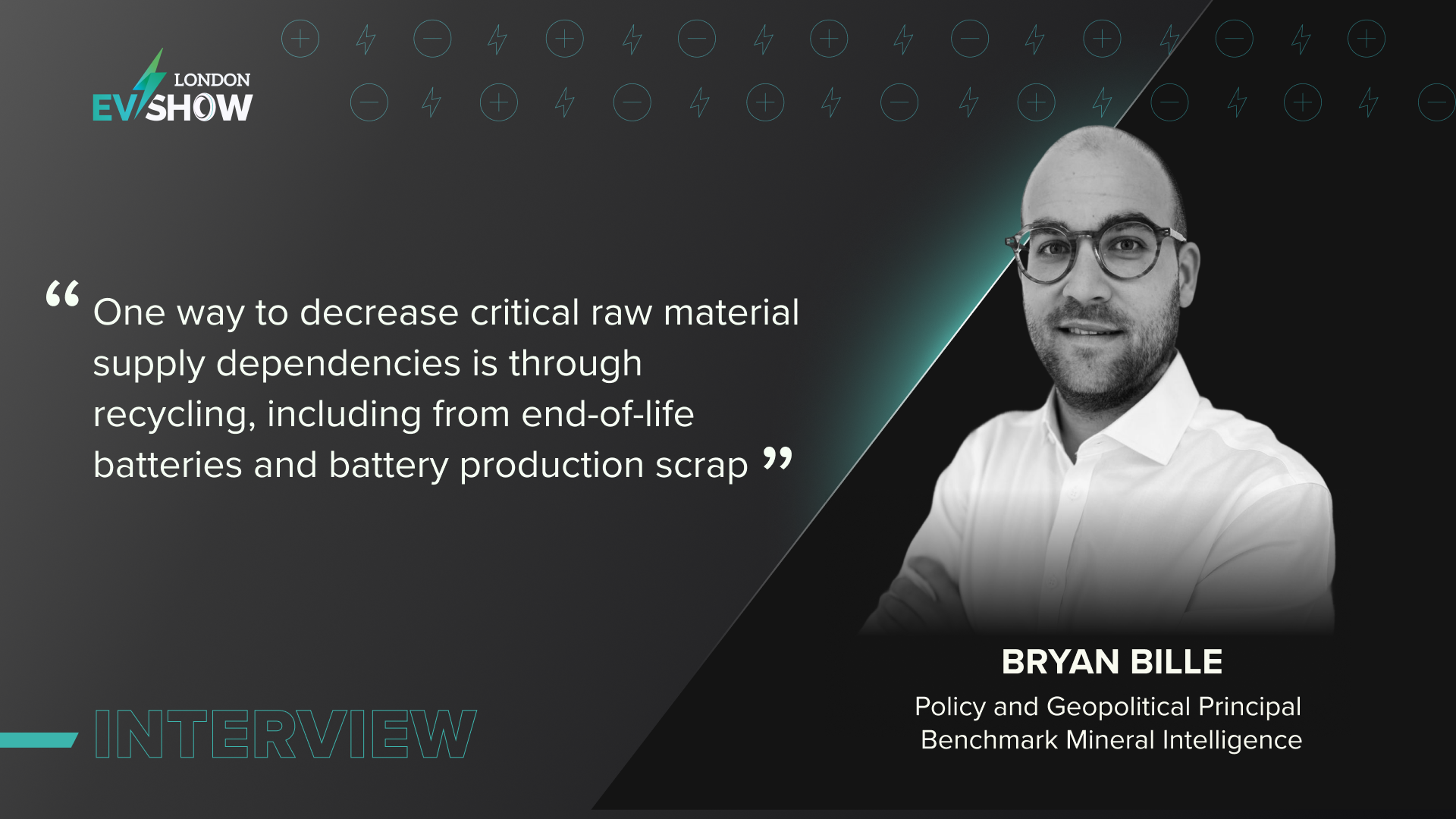Bryan Bille, Policy and Geopolitical Principal at Benchmark Mineral Intelligence, joined Ambreen Mir for an in-depth Q&A session exploring the intersection of policy, geopolitics, and the evolving EV battery landscape. Drawing on his extensive background in international trade, industrial strategy, and political economy—including past roles within the Belgian government—Bryan unpacked the critical supply chain vulnerabilities facing the global battery market. He emphasised the need for circular economy models, advanced recycling infrastructure, and smarter public-private funding mechanisms to mitigate raw material dependency. Bryan also reflected on China’s technological lead, the implications of U.S. policy shifts, and the uncertain commercial trajectory of alternative chemistries like sodium-ion. As the London EV Show convenes global industry leaders, his insights point to resilience, affordability, and international cooperation as central to shaping a secure and sustainable battery future.
Ambreen: With the rising demand for EVs and energy storage, how can the battery industry build a more resilient and sustainable supply chain while reducing dependence on raw material mining?
Bryan Bille: One way to decrease critical raw material supply dependencies is through recycling, including from end-of-life (EOL) batteries and battery production scrap. All this explains why geopolitical actors like the European Union (EU) aim to develop a local circular economy by supporting the development of vertically integrated “closed-loop” battery recycling facilities and a single market for battery recycling feedstock. Building out recycling capacity, especially refining capacity to process black mass into valuable chemicals to produce battery cathodes, in Europe is challenging though, due to environmental permitting, high capital costs, technical difficulties, and intense competition for recycling feedstock as well as the slower-than-expected buildout of the battery midstream.
Current recycled or secondary raw material volumes are relatively low, and battery recycling before 2030 will be minimal compared with the forecast demand growth for batteries and critical raw materials. Nevertheless, the secondary raw material supply will grow significantly after 2030-2035 once EOL batteries become widely available.
Furthermore, emerging alternative battery technologies, like sodium-ion (see below), which use no lithium, cobalt, or nickel, could make mining some raw materials less critical. Although the extent to which these technologies will be commercialised and deployed against the current lithium-ion battery technologies remains to be seen at this stage.
Ambreen: Benchmark Mineral Intelligence plays a key role in tracking the battery supply chain. Based on your insights, what are the biggest bottlenecks in the global battery raw material market today?
Bryan Bille: The first significant bottleneck is the long lead times in developing mining projects from discovery to commercial production, especially in areas like Europe and the US. The average lead time for developing a raw material mining project is between 15 and 25 years, depending on the raw material, mainly due to lengthy and complex permitting and ESG procedures. The long lead times for developing new commercial, fully operational projects create supply vulnerabilities, making it challenging to ramp up production, which is needed given the forecasted raw materials supply deficits to meet battery demand towards and beyond 2030.
Secondly, raw material projects face difficulties accessing (private) capital investment due to long project development lead times, the social and environmental concerns around mining projects, and the large-scale and capital-intensive nature of mining projects. Price volatility and especially the current low price environment further complicate investment decisions in greenfield projects and affect ongoing raw material projects' cost competitiveness and profitability. As a result, there seems to be a growing need to derisk raw material projects through smart and innovative public funding mechanisms, including temporary price support mechanisms and public-private partnerships, especially in this low-price environment.
Ambreen: As governments push for localised battery production, what are the biggest challenges and opportunities for the U.S. in establishing a competitive and self-sufficient battery ecosystem?
Bryan Bille: While the second Trump Administration is looking to bolster US mining and processing to localise supply and reduce dependencies on China, this US administration also aims to reduce federal government support for US battery and other cleantech projects through the Inflation Reduction Act (IRA) and Bipartisan Infrastructure Law (BIL) rollbacks. Since the IRA and the BIL have been key to the clean industrial renaissance in the US, rollbacks will not only affect local battery and cleantech build-out, but would also affect the demand drivers for developing local raw material supply chains, in turn affecting the investment attractiveness of domestic upstream projects (mining and processing).
Moreover, in terms of supply dependencies and technological catch-up, it is essential to underscore that China has not only a significant technological edge in terms of cell production, especially for LFP, but also across the wider supply chain, including upstream technology (HPAL, DLE, etc) and pCAM manufacturing. Consequently, it will be challenging for the US to catch up due to the huge resources China has poured into the sector, their head-start, and overall political will to be the global cleantech leader.
Ambreen: With advancements in battery technology and supply chain strategies, how do you see the balance shifting between lithium, nickel, and emerging alternatives like sodium-ion batteries?
Bryan Bille: The rapidly evolving lithium-ion battery industry has broadly resulted in a bifurcated market with two leading technologies: the NCM (nickel-cobalt-manganese-oxide) chemistry and the more affordable but less energy-dense LFP (lithium-iron-phosphate) chemistry, which contains neither cobalt nor nickel. Globally, LFP batteries’ market share has increased significantly since 2020 and held the largest market share of lithium-ion battery cell production with 46% in 2024, while considering all NCM variants, NCMs take up a similar share.
LFP cells are primarily needed to meet the demand for more affordable EVs and, given their safety characteristics and cycle life, are expected to remain the dominant technology for energy storage systems (ESS). Technological improvements in energy density helped narrow the gap with NCM chemistries.
Although alternative battery technologies, such as solid-state, silicon anodes and sodium-ion, have been emerging and are under development, no alternative technology is available at a scale that meets the same performance as current technologies and will take time to mature and commercialise fully. For any new technology looking to gain market share, there must be a clear benefit (performance, costs, etc) over incumbent technologies to succeed. For instance, sodium-ion batteries are gaining traction. China is already leading the race for this next generation of batteries, with an estimated dominant market share of nearly 100 per cent of global production. But, despite recent moves in the commercialisation of sodium-ion batteries in China, the market outlook of sodium-ion batteries remains somewhat uncertain.
Against this background, it is unlikely that any technology will come around and be a "lithium killer"; instead, new technologies should be seen as complementary rather than competitive, enabling applications to choose the battery technology that best suits their requirements. Naturally, the maturity of these technologies will take time, and the market share of lithium-ion will be eroded as they are commercialised, but it is more about defining where these technologies fit, rather than when lithium-ion will be replaced.
Ambreen: As the industry gathers at the London EV Show, what key trends and discussions do you anticipate will take centre stage in shaping the future of battery technology and electric mobility?
Bryan Bille: Growing geo-economic fragmentation—particularly with tariffs at the forefront—continues to dominate conversations in the battery and EV sectors. Nevertheless, the global EV market is seeing significant momentum, with sales up 29% year-to-date (January–April 2025 vs. January–April 2024). The EU has emerged as a standout, recording a 25% growth in EV sales so far in 2025.
At the London EV Show, I expect supply chain resilience through localisation and diversification to be a central topic once again. A major point of discussion will be China’s continued dominance across the battery and EV supply chains. Balancing decarbonisation goals with efforts to “derisk” these supply chains from China presents complex trade-offs, given its technological lead and market control.
As will likely be highlighted at the show, EU policymakers increasingly recognise that Europe depends on the advanced Asian battery ecosystem—including Chinese players—and that continued Asian involvement is essential for scaling capital- and tech-intensive battery production locally. However, this participation must come under the right conditions and balanced partnerships. In response, the EU is now considering elements of China’s EV and battery strategy, such as joint venture requirements, local content rules, and conditional subsidies tied to IP and tech transfers—tactics China has applied for decades to Western companies.
Finally, EV affordability—a key factor in accelerating mass adoption—will be a big discussion point at the London EV Show, especially as industry leaders and policymakers explore how targeted policy measures can help make EVs more accessible and drive progress on decarbonisation.


